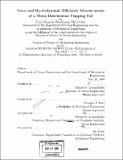Force and hydrodynamic efficiency measurements of a three-dimensional flapping foil
Author(s)
McLetchie, Karl-Magnus Weidmann
DownloadFull printable version (3.072Mb)
Other Contributors
Massachusetts Institute of Technology. Dept. of Mechanical Engineering.
Advisor
Michael S. Triantafyllou and Douglas P. Hart.
Terms of use
Metadata
Show full item recordAbstract
Investigations into unsteady flapping foil propulsion have shown that it is an efficient and high thrust means of propulsion. Extensive work has been done to optimize the efficiency of two-dimensional flapping foils, varying both the kinematics of the motion and the flexibility of the foil. However, no thorough investigation into the hydrodynamic efficiency of three-dimensional flapping foils has been made. In this thesis, experimental hydrodynamic efficiency measurements and force measurements of a three-dimensional flapping foil are presented. These measurements were made by mounting a small, six-axis dynamometer directly onto the foil shaft of a flapping foil module. The module uses two computer controlled servo motors to actuate a foil in a sinusoidal pitch and roll motion, similar to the motion of a penguin's wing. The measured thrust coefficients compared well to previous experimental results, and the on-shaft dynamometer proved to be a valuable sensor. However, the experimental apparatus must be modified before reliable efficiency results can be made for the entire range of kinematics. (cont.) Once these improvements are made, a thorough investigation into the effects of foil geometry and flexibility can be done to find the optimum efficiency parameters of a three-dimensional flapping foil. These optimum efficiency parameters will be valuable for the development of flapping foil vehicles.
Description
Thesis (S.M.)--Massachusetts Institute of Technology, Dept. of Ocean Engineering; and, (S.M.)--Massachusetts Institute of Technology, Dept. of Mechanical Engineering, 2004. Includes bibliographical references (p. 69-70).
Date issued
2004Department
Massachusetts Institute of Technology. Department of Mechanical Engineering; Massachusetts Institute of Technology. Department of Ocean EngineeringPublisher
Massachusetts Institute of Technology
Keywords
Ocean Engineering., Mechanical Engineering.